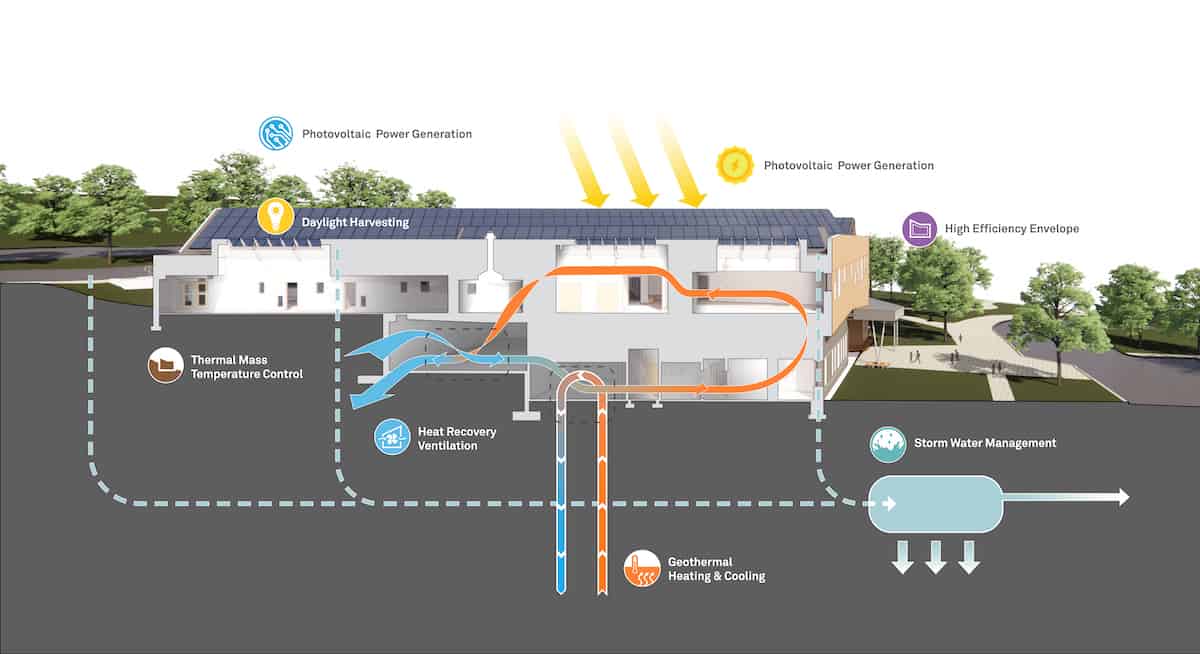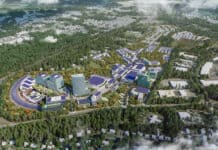By Gary Brock, AIA, LEED AP BD+C and Mike O’Brien
When planning new schools, a key question is how to best achieve maximum carbon reduction, energy efficiency, and community health. Fortunately, opportunities available today to reach a Net-Zero Energy — or even a Net-Positive Energy outcome — make these goals not only feasible, but achievable.
What’s changing? The path forward for highly sustainable outcomes, including Net-Zero Energy (NZE) schools, is getting easier. We see two related reasons:
- The life cycle cost of NZE is steadily improving. Not only are utility costs continuing to rise, but ever-improving performance, availability, and options for sustainable design components drive up-front costs down.
- This more beneficial economic equation, coupled with a growing concern over climate change, is creating a steady rise in community action plans and general community support for NZE and clean energy initiatives.
Fales Elementary School, a Net-Positive Energy school project in the Westborough, MA, is an example of these advancements. Opened in November 2021, the school is projected to generate 11.6% more on-site energy annually than required to operate the all-electric school.

The Fales School achieves this net-positive performance by consuming far less energy — less than two-thirds that of a code-compliant building — while also harnessing on-site renewable energy sources. Forty geothermal wells heat and cool the building while a 25,000 square-foot rooftop solar array generates renewable power. The project is the first completed towards achieving the Town’s goal of becoming carbon-emissions free by 2035.
Based on this experience designing and building the Fales Elementary School and other recent projects, we identified lessons learned to help guide facilities executives and their project partners to net-zero energy (NZE) success.
1. Determining Feasibility at the Earliest Possible Stage
Investigating the feasibility of a proposed school project’s technical, financial, and classroom health opportunities requires a comprehensive, data-driven approach from the start. A purposeful, team-based early phase planning process is essential to define project potential and accurately communicate the cost/benefits of achieving a community’s desired goals.
An important prelude to success in the planning phase is selecting the right team. NZE initiatives require informed expertise and dialog across multiple disciplines. The team for the Fales School included the architects, the Town, the construction manager, geotechnical, mechanical, and electrical engineers, renewable energy consultants, energy modelers, and public utilities all working together to come up with practical and constructible solutions.
2. Identifying Opportunities and Tradeoffs During Schematic Design
Too often, project teams opt to wait until the later stages of design to make the tough decisions. More than 30% of the school’s energy performance savings achieved for the Fales project were determined before or during the Schematic Design phase. Fine-tuning the design in later stages helped achieve additional savings, but the range of options to reduce energy demand diminishes as the design progresses. In other words, the commitment to pursue a NZE building needs to take place early in the design process.
Choosing an all-electric energy strategy set the stage for hundreds of decisions to meet the Town’s targets. Other impactful decisions include building orientation, massing and placement, envelope performance, and systems.
Early passive high-performance choices significantly influence the size, type, and initial cost of HVAC and lighting systems. In the case of Fales, ground-source heat pumps (GSHP) became an integral component in the strategy to maximize both energy savings and production. Available roofscape was maximized for PV panels by locating air handlers inside the building enclosure and by using ground source heat pumps, maximizing energy production.

3. Setting Shared, Clear Goals
Establishing purposeful and attainable strategic NZE goals at the project’s outset gave the Fales team a clear road map for decisions. It became the basis for community dialog and consensus-building. Once established, the shared project goals and vision also help keep the “eye on the prize” when the inevitable headwinds arrive.

One key energy performance goal is the building’s target Energy Use Intensity (EUI). EUI defines the amount of energy per square foot needed to operate the building over the course of a year (kBTU/sf/yr).
At the Fales School, we set an ambitious EUI goal of 25. For comparison, the benchmark EUI for new K-12 schools in the U.S. is 45.
4. Minimizing EUI Through Design & Behavior
A critical objective for a NZE outcome is to explore and validate every option to reduce the energy load of the building. Every reduction implemented into the design translates to a) lower EUI within the school and b) potential scale and cost savings on the capital outlay for onsite renewable investments (solar, wind, geoexchange, etc.)
This approach proved invaluable for the Fales School’s net energy use. Tactics for minimizing in-school EUI through design innovation included optimal solar orientation and shading, roof and wall insulation that is 40% above code requirements, LED lighting with daylight and occupancy sensors, and high-efficiency mechanical systems. The integrated savings within the building defined the size of onsite renewable systems: a 25,000 square-foot rooftop solar array and 40 GSHP wells for heating and cooling.
An important consideration is how the building is used. Human behavior, much as it impacts the fuel economy of a car based on how it is driven, also influences a building’s EUI based on schedule and maintenance patterns.
5. Achieving Mechanical System Optimization
On most school projects, achieving a NZE outcome is difficult using solely photovoltaics. GSHP technology can be a viable option for many facilities to help get there.
A hydronic-based GSHP system that heats and cools the building utilizing a closed- or open-loop can be highly energy-efficient. The second type of energy-efficient heat pump system is a VRF system that utilizes refrigerant loops throughout the building and the air rather than the ground to reject/absorb heat.
Many factors influence which of these systems to use. Underground wells can require more real estate and are drilled to depths between 300-900 feet for vertical closed-loop systems (typical in the Northeast). The energy performance benefits of GSHPs need to be weighed against the site disruption of well installation. One important advantage of GSHPs is the increase in the amount of available roofscape available for photovoltaic panels to produce renewable energy.
The air-source heat pumps are often selected when the site cannot support vertical or horizontal ground loops. Schedule constraints, subsurface conditions, and lack of space can all contribute to choosing VRF systems over GSHP systems.
Takeaways
The shift towards more sustainable schools comes at an opportune time. With schools nationwide spending approximately $8 billion per year on energy costs, there may never be a better time to move toward a healthier, cleaner, and ultimately less energy-intensive future.
When commencing NZE facility strategies, stakeholders need to understand that the upfront investment may be higher than conventional approaches. It is a complex balance of construction cost, utility rates, school building utilization, climate variables, production capacity, financing, and funding opportunities, all of which can vary dramatically regionally and locally. Financial forecasting should include the long-term operational benefits, an advantage because energy costs will continue to rise, and costs due to greater emissions will continue to increase as they impact our climate and local weather events.
The long-term value of a Net-Zero or Net-Positive Energy school, one that eliminates or significantly reduces reliance on traditional fossil fuels, is not only sensible — but also attainable.
 Brock, AIA, LEED AP BD+C is an Associate with HMFH Architects in Cambridge, Massachusetts. He is one of the firm’s sustainability leaders, exploring new technologies and materials, developing guidelines to integrate high performance design into each project, and developing strategies to quantify outcomes. He is also an adjunct faculty member at the Boston Architectural College where he teaches the Building Technology Course in conjunction with the comprehensive studio for the Distance Master of Architecture Program.
Brock, AIA, LEED AP BD+C is an Associate with HMFH Architects in Cambridge, Massachusetts. He is one of the firm’s sustainability leaders, exploring new technologies and materials, developing guidelines to integrate high performance design into each project, and developing strategies to quantify outcomes. He is also an adjunct faculty member at the Boston Architectural College where he teaches the Building Technology Course in conjunction with the comprehensive studio for the Distance Master of Architecture Program.
 O’Brien is senior vice president and business unit leader for Gilbane in Massachusetts. In this role, he oversees all operations and personnel in the business unit, with a focus on client satisfaction, training, and staff development. Under O’Brien’s leadership, the Massachusetts office is delivering iconic projects such as Alnylam Pharmaceuticals New Biopharmaceutical Manufacturing Facility in Norton, the Hobbs Brook 225 Wyman office/lab development in Waltham, and the recently completed new Minuteman Regional Vocational Technical High School in Lexington.
O’Brien is senior vice president and business unit leader for Gilbane in Massachusetts. In this role, he oversees all operations and personnel in the business unit, with a focus on client satisfaction, training, and staff development. Under O’Brien’s leadership, the Massachusetts office is delivering iconic projects such as Alnylam Pharmaceuticals New Biopharmaceutical Manufacturing Facility in Norton, the Hobbs Brook 225 Wyman office/lab development in Waltham, and the recently completed new Minuteman Regional Vocational Technical High School in Lexington.



















![[VIDEO] Collect Asset Data at the Speed of Walking a Building](https://facilityexecutive.com/wp-content/uploads/2024/02/maxresdefault-324x160.jpg)